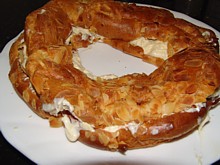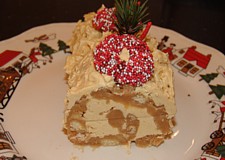Add 30 gram of the butter to 1/2 cup milk and bring this to the
boil. Simmer slowly until the butter has dissolved. Add 100 gram
flour at once, while the pan is on low heat, and stir well, until
the dough forms a ball. Turn off the heat. Allow the dough to cool
down for 10 minutes, then add 2 eggs, one by one. Mix well until
smooth. Make a circle on a greased baking tin with a diameter of
approximately 20 centimeter. Sprinkle it with shaved almonds and
bake for half an hour at 175 degrees
Celsius. Allow it to cool down and cut it open. Melt the
remaining butter with the rest of the flour whilst stirring. Add the
remaining milk, the sugar and the vanilla sugar and bring to the
boil, stir well. Simmer for 2 minutes. Turn the heat very low, add
two egg yolks, stir well, heat for 30 seconds. Allow this mixture to
cool down and then mix it with the whipped cream. Pipe this mixture
on the bottom half of the pastry and close it with the top half.
Paris-Brest was invented in 1891 by a baker who
lived alongside the route of the bicycle tour "Paris-Brest" and the
pastry is supposed to reflect a bicycle wheel.
|
Put
the lady fingers together with the rum and 100 gram very soft butter
and make sure all is mixed well. Spread the mixture over a sheet of
baking paper and roll it up. Refrigerate for 2 hours. In the
meantime, whisk the remaining butter with the sugar, the egg yolks
and the coffee. Carefully roll out the lady finger sheet and spread
a layer of the coffee cream on it; roll it up again and cover the
outside as well, make patterns with a fork. Refrigerate for another
2 hours. Decorate with Christmas items.
|

